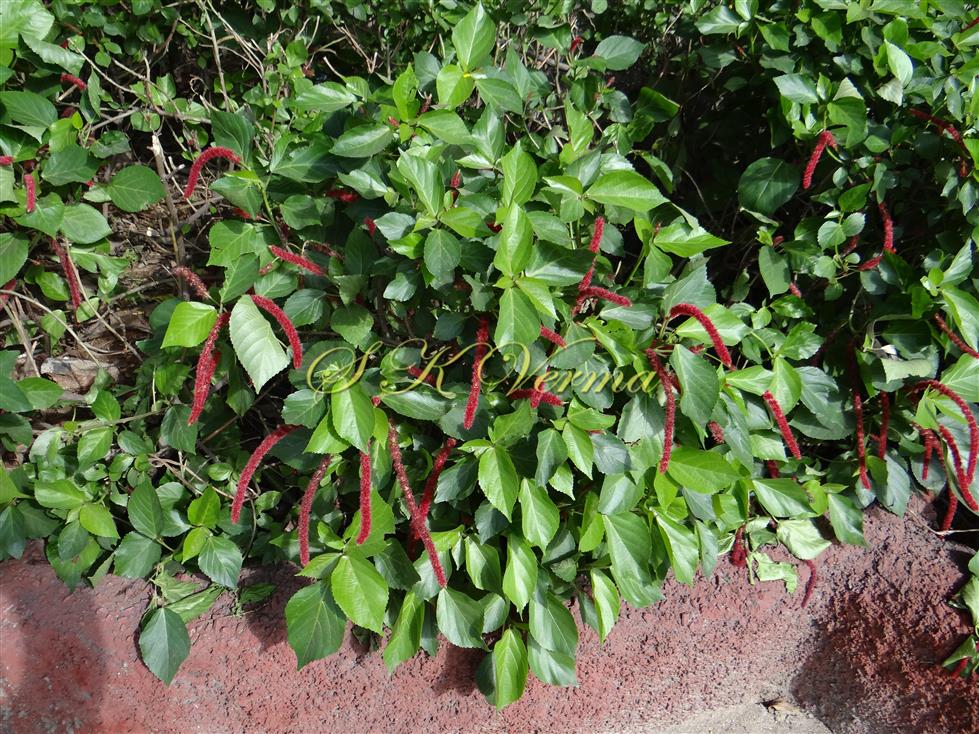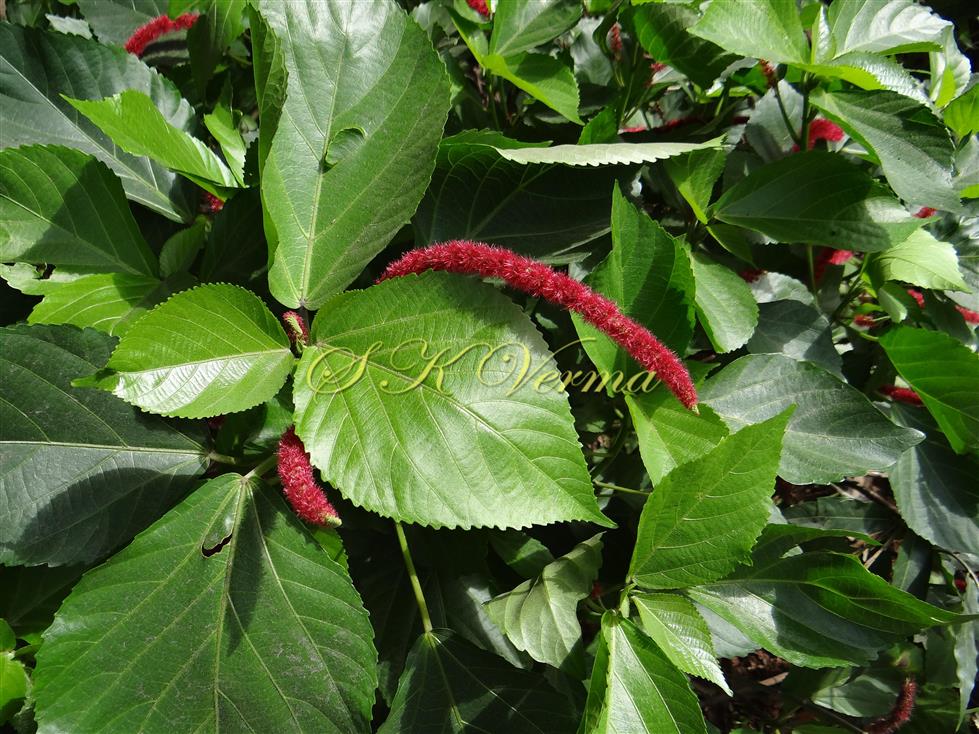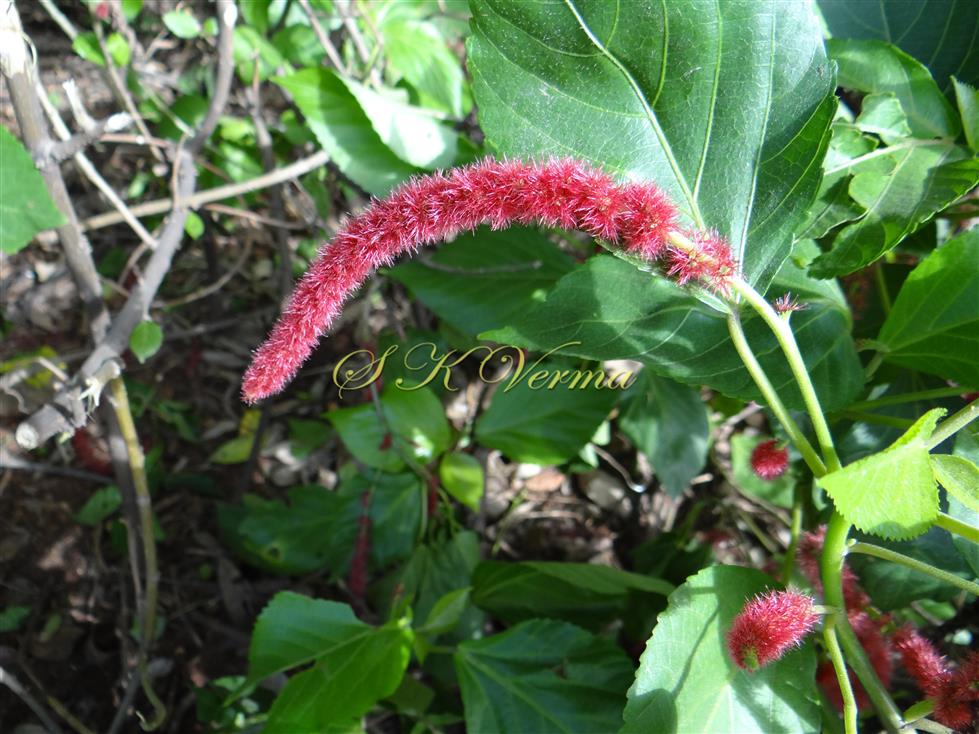ACALYPHA
Acalypha
L., Sp. Pl. 2: 1003. 1753; Gen. Pl. ed. 5: 436. 1754; Muell. Arg. in DC., Prodr. 15(2): 799. 1866; Benth. & Hook. f., Gen. Pl. 3(1): 311. 1880; Hook. f., Fl. Brit. Ind. 5: 414. 1890; Collett, Fl. Smil. ed. 2: 452. 1921 (Reprint 1980); Qiu & Gilbert, Fl. China @ eFlora.org 11: 251; Levin, Fl. North Amer. @ eFloras.org vol. 12; Radcliffe-Smith, Fl. Pak. @ eFloras.org p. 61.
Monoecious, rarely dioecious annual or perennial unarmed herbs, shrubs or rarely trees. Latex absent. Indumentum simple, sometimes glandular. Leaves alternate; stipules lanceolate, subulate or minute, deciduous; long petiolate; leaf blade simple, ovate, pointed, often toothed and penninerved, laminar glands absent. Inflorescence axillary or terminal or both, mostly unbranched, spicate or racemose, bisexual or unisexual, sexes diversely arranged, mostly bisexual with male flowers in fascicles distally along slender axis, base with 1-few female flowers, mostly enclosed within prominent leafy bracts. Male flowers: Small, associated with small bract, shortly pedicellate. Calyx closed in bud, later valvate, 4-partite, membranous. Petals 0. Disc absent. Stamens 8; filaments free, broad; anther thecae distinct, spreading or pendulous, oblong or linear, later flexuous-vermiform. Pistillode absent. Female flowers: 1-3 per bract, often sessile; bracts often dentate or lobed, accrescent in fruit. Sepals 3-5, shortly connate, imbricate. Petals, disc and staminodes absent. Ovary (2 or) 3-locular, 1 ovule per loculus, placentation axile; styles mostly free or connate, laciniate or fimbriate, often reddish hued. Fruit a capsule, 2 or 3-lobed, small, dehiscing septicidally into bivalved cocci. Seeds subglobose or ovoid, often with a ventral ridge, smooth; caruncle and aril absent.
443 species
Acalypha hispida
Acalypha hispida
Burm. f., Fl. Ind. 303: t. 61, f.1. 1768; Muell. Arg. in DC., Prodr. 15(2): 815. 1866; Hook. f., Fl. Brit. Ind. 5: 417. 1890; Pax in Engl. Pflanzenreich 4. 147. 16: 140. 1924; Fl. China @ eFlora.org 11: 254; Fl. Pak. @ eFloras.org p. 66.
Perennial dioecious shrub, 1-3 m tall, stem much branched, young shoots tomentose, later sparingly puberulous or glabrescent. Leaves alternate; petioles 1-5 cm long; leaf blade ovate to rhombic-ovate, 8-20 cm x 5-14 cm, apex acute or acuminate, base broadly cuneate, obtuse or subcordate, margin coarsely serrate, 5-nerved at base, sparingly pubescent above and beneath, especially on midrib and veins, later glabrescent, bright green, veins often reddish. Stipules triangular or lanceolate, 5-10 mm long, pilose. Inflorescence axillary, solitary, spicate, shortly pedunculate. Female inflorescences up to 30 cm long, pendulous, very densely flowered, with a puberulous axis and minute ovate or ovate-rhombic bracts, ca. 1 mm long, entire. Female flowers: Sessile. Sepals 3-4, subovate, 0.7-1 mm long, acute, puberulent. Petals absent. Ovary subglobose, trilobate, ca. 1 mm in diameter, densely hirtellous (or pubescent); styles 3, +/- free to base, 5-7 mm long, laciniate, crimson or red- purple giving colour to inflorescence.
Male plants not observed.
Common Names: Philippines Medusa, Cat’s Tail, Red-hot Cat’s Tail, Fox Tail, Chenille Plant


-Sparingly pubescent-DSC02545.jpg)




-Sparingly pubescent-DSC02545.jpg)
